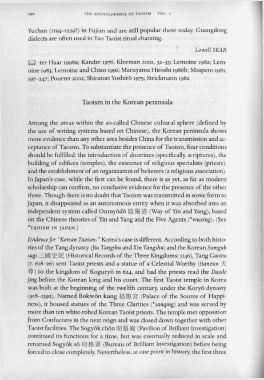Page 230 - The Encyclopedia of Taoism v1_A-L
P. 230
190 THE ENCYCLO PEDIA OF TAOI SM VOL . I
Yuchan (II94-1229?) in Fujian and are still popular there today. Guangdong
dialects are often used in Yao Taoist ritual chanting.
LowellSKAR
m ter Haar 1998a; Kandre 1976; Kleeman 2002, 32-33; Lemoine 1982; Lem-
oine 1983; Lemoine and Chiao 1991; Maruyama Hiroshi 1986b; Maspero 1981,
197-247; Pourret 2002; Shiratori Yoshir6 1975; Strickmann 1982
Taoism in the Korean peninsula
Among the areas within the so-called Chinese cultural sphere (defined by
the use of writing systems based on Chinese), the Korean peninsula shows
more evidence than any other area besides China for the transmission and ac-
ceptance of Taoism. To substantiate the presence of Taoism, four conditions
should be fulfilled: the introduction of doctrines (specifically, scriptures), the
building of edifices (temples), the existence of religious specialists (priests),
and the establishment of an organization of believers (a religious association).
In Japan's case, while the first can be found, there is as yet, as far as modern
scholarship can confirm, no conclusive evidence for the presence of the other
three. Though there is no doubt that Taoism was transmitted in some form to
Japan, it disappeared as an autonomous entity when it was absorbed into an
independent system called Onmyodo ~MiJJ!! (Way of Yin and Yang), based
on the Chinese theories of Yin and Yang and the Five Agents (*wuxing). (See
*TAOISM IN JAPAN.)
Evidence for "Korean Taoism." Korea's case is different. According to both histo-
ries of the Tang dynasty (Jiu Tangshu and Xin Tangshu) and the Korean Samguk
sagi -= ;! ~ ~c (Historical Records of the Three Kingdoms; II46), Tang Gaozu
(r. 618- 26) sent Taoist priests and a statue of a Celestial Worthy (tianzun 7(
.) to the kingdom of Koguryo in 624, and had the priests read the Daode
jing before the Korean king and his court. The first Taoist temple in Korea
was built at the beginning of the twelfth century, under the Koryo dynasty
(918-1392). Named Bokwon kung :mI?J-g (Palace of the Source of Happi-
ness), it housed statues of the Three Clarities (*sanqing) and was served by
more than ten white-robed Korean Taoist priests. The temple met opposition
from Confucians in the next reign and was closed down together with other
Taoist facilities. The Sogyok cMn fIB ~ ~ (Pavilion of Brilliant Investigation)
continued its functions for a time, but was eventually reduced in scale and
renamed Sogyok so A11~~ (Bureau of Brilliant Investigation) before being
forced to close completely. Nevertheless, at one point in history, the first three

